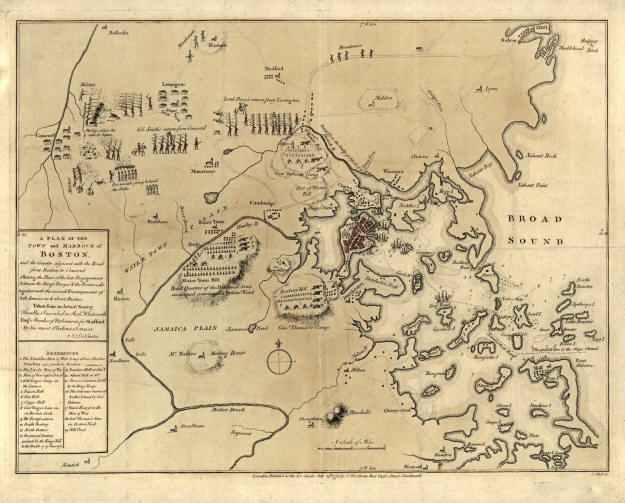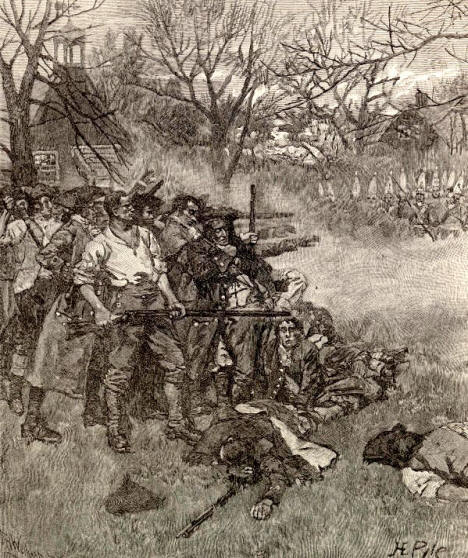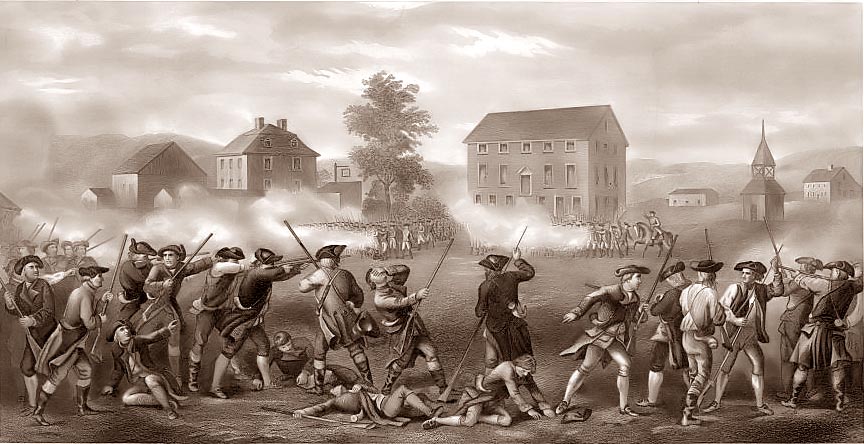The Battle of Lexington and Concord
|
|
This Site:
|
Original 1775 Map of the Battle of LexingtonLexington and Concord, Battle of. In the early spring of 1775, General Gage had between 3,000 and 4,000 troops in Boston, and felt strong in the presence of rebellious utterances that filled the air. He observed with concern the gathering of munitions of war by the colonists. Informed that a considerable quantity had been deposited at Concord, a village about 16 miles from Boston, he planned a secret expedition to seize or destroy them. Towards midnight, on April 18, he sent 800 men, under Lieutenant-Colonel Smith and Major Pitcairn, to execute his designs. The vigilant patriots had discovered the secret, and were on the alert, and when the expedition moved to cross the Charles River, Paul Revere, one of the most active of the Sons of Liberty in Boston, had preceded them, and was on his way towards Concord to arouse the inhabitants and the minute-men. Soon afterwards church bells, musketry, and cannon spread the alarm over the country; and when, at dawn, April 19, Pitcairn, with the advanced guard, reached Lexington, a little village 6 miles from Concord, he found seventy determined men, under Capt. Jonas Parker, drawn up on the green to oppose him. Pitcairn rode forward and shouted, "Disperse! disperse, you rebels! Down with your arms, and disperse!" They refused obedience, and he ordered his men to fire. The order was obeyed, and the Revolutionary War was thus begun. Eight minute-men—good citizens of Massachusetts — were killed, several others were wounded, and the remainder were dispersed. It was now sunrise. On that occasion Jonathan Harrington, a youth of seventeen years, played the fife.
Battle of Lexington The British then pressed forward towards Concord. The citizens there had been aroused by a horseman from Lexington, and the militia were flocking towards the town from every direction. The stores were hastily removed to a place of concealment, in carts and other vehicles, by men, women, and children. The Middlesex farmers, armed with every conceivable kind of firearms, were drawn up in battle array in defense of their homes and their chartered rights. Major Buttrick and Adj. Joseph Hosmer took the chief command. The British had reached the North Bridge. Colonel Barrett, then in command of the whole, gave the word to march, and a determined force, under Major Buttrick, pressed forward to oppose the invaders, who were beginning to destroy the bridge. The minute-men were fired upon by the British, when a full volley was returned by the patriots. Some of the invaders fell; the others retreated. They had destroyed only a few stores in the village. The invaders were terribly smitten by the gathering minute-men on their retreat towards Lexington. Shots came, with deadly aim, from behind fences, stonewalls, and trees. The gathering patriots swarmed from the woods and fields, from farmhouses and communities. They attacked from ambush and hidden places along the open highway. It was evident to the Britons that the whole country was aroused. The heat was intense; the dust intolerable. The 800 men would have been killed or been captured, had not a reinforcement, under Lord Percy, met and relieved them near Lexington. After a brief rest, the whole body, 1,800 strong, retreated, and were terribly assailed along the whole 10 miles to their shelter at Charlestown, narrowly escaping 700 Essex militia, under Colonel Pickering, marching to strike their flank. Under the guns of British war vessels, the remnant of the detachment rested that night, and passed over to Boston the next morning. During the expedition the British lost, in killed, wounded, and missing, 273 men; the Americans lost 103.
Minutemen at the Battle of Lexington When news of the affair at Lexington and Concord went over the land, the people were everywhere aroused to action, and never before nor afterwards was there so unanimous a determination to resist British oppression. In wavering New York there was unity at once, and the custom-house was immediately closed, and all vessels preparing to sail for Quebec, Newfoundland, Boston, or Georgia were detained—the latter colony not having yet sent delegates to the Continental Congress. The New - Yorkers addressed a letter to the mayor and aldermen of London—from whom Boston, in its distress, had received sympathy and aid—declaring that all the horrors of civil war could not compel the colonists to submit to taxation by the British Parliament. The inhabitants of Philadelphia followed those of the city of New York. Those of New Jersey took possession of the provincial treasury, containing about $50,000, to use for their own defense. The news reached Baltimore in six days, when the people seized the provincial magazine, containing about 1,500 stand of arms, and stopped all exports to the fishing-islands, to such of the islands as had not joined the confederacy, and to the British army and navy at Boston. In Virginia a provincial convention was held, which took measures for the defense of the Colony.
Drawing of the Battle at Lexington in the Revolutionary War |
|
|
||
|
|
Site Copyright 2003-2018 Son of the South. For Questions or comments about this collection, contact: paul@sonofthesouth.net |
|
|
Are you Scared and Confused? Read My Snake Story, a story of hope and encouragement, to help you face your fears. |
||



